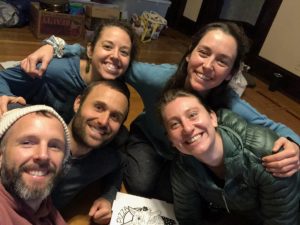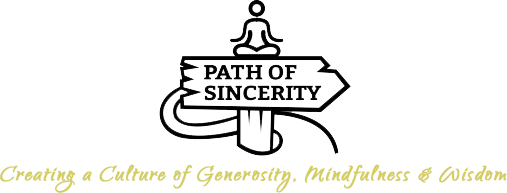
The following reflection originally appeared in the newsletter I sent out on November 3rd, 2022.
——-
Introduction
In this newsletter, I usually break down some facet of meditation or the dharma. However, today I’m going to get much more personal than normal, and explore this meditator’s experience of a very relatable life event: moving!
To be more specific, this past weekend I moved out of a community house with some dear friends and into a home with my girlfriend, her sister, and her best friend. Amidst this transition, I have noticed four dominant experiences:
- Sadness
- Excitement
- Exhaustion
- Balance
In the rest of the reflection, I’ll be going through those four one-by-one, and reflecting on how meditation and/or the dharma relates to that experience.
The Part about Sadness
Four and a half years ago, I was about a year back into Portland after many years of travel and intensive meditation. I had the desire to live more communally and intentionally in my home life. This desire birthed a home that in total would have 11 people roll through, no more than 5 at once, including a few that stuck around most of that time and have become some of my dearest friends.
This past weekend, that chapter closed; or, as one of my favorite haiku goes (by Masaoka Shiki):
I go,
you stay;
two autumns.
In closing this chapter, I’ve felt lots of tenderness. Nostalgia. Many fond memories. Some difficult ones, which were certainly great catalysts for emotional & spiritual growth — so a fondness there too! Cherishing those Deep Covid days when we quarantined together. Likewise cherishing all the many mini-chapters we’ve supported, counseled, and cheerleaded each other through. On Sunday, we had a sweet closing circle with pizza and cacao, and one final group selfie (see above)!
In saying goodbye to that chapter, I don’t feel any kind of overwhelming sadness. It’s more a tender appreciation of what was. Creates some ripples in my chest. The dharma has taught me how to just be with that. I don’t need to conjure up more sadness to “really feel it” or “truly honor it,” and I likewise don’t need to make it go away or hastily toss on some equanimity goggles to be a stone-faced Buddha statue about it. I just be-with what here’s: a tender appreciation of what was.
The Part about Excitement
After spending most of my 20s and early 30s as a spiritual nomad and lonewolf, these last handful of years I’ve been more interested in building roots, connection, and community. This step of moving in with a partner and into an even more integrated, family-style home feels like a natural progression. And it feels good!
Curiously, I don’t feel any noteworthy fear or doubt. I suspect this has something to do with a lot of inner clarity about who I am and what my values are, and likewise just a true resonance with my partner. But I suppose another part is knowing that my life has fallen apart before and I made it through alright, so if this falls apart, I deeply trust my resilience (and hers) to make it through that alright.
And, without the fear or doubt, largely what I feel is excitement, joy, the beauty of a new chapter, and a relational deepening. It also helps that the person I’m dating is… awesome! Gentle and patient and calm and fun and seeing the best in me!
As I reflect on this excitement, the dharma again just shows me how to be with it as it is. Appreciating the delight, but not trying to grasp onto it and make it last as long as possible. To likewise not get carried away with the future, whether that be expectations, desires, and so on. To just be here now with what’s happening, and so there’s the sadness of the going, but also the delight and excitement of the stepping into. Here for it all!
The Part about Exhaustion
Oh my goodness, it is a lot of work to move 5 people out of a 4,000-square-foot house and clean it.
When I got home on Saturday night, I landed on the bed and slept for 10 hours straight like a rock. So many stairs. My calves are only just now recovering. My triceps probably grew in size. Half my possessions are still in boxes — where are my earphones you ask, well I’m wondering the same thing! So much cleaning. Sweeping and moping and goodwill runs and packing and unpacking and scrubbing and more scrubbing, and on and on.
In the past, I’ve been a bit more aspirational about how much I can move in a limited period of time. This go-round, anticipating the large amount of work involved, I blocked three and a half days in my schedule for the move. While it was still physically exhausting, there’s a way that thoughtful reflection got me to make appropriate arrangements, so the physical exhaustion didn’t become mental-emotional overwhelm (like having to stay and clean past midnight on the last day and then have a full workday starting hours later — been there!).
I reflect that mindfulness also helped me be cognizant of my limits — I took many little breaks, had snacks, stepped outside, and engaged in friendly chatter along the way. I felt no need to hurry or go-go-go every second of the weekend. Exhaustion or just feeling tired doesn’t have to sink us if we’re mindful about it.
The Part about Balance
One of my housemates thanked me at the end of the big cleaning day for staying so grounded and calm throughout the day. I appreciated the feedback, though it was also curious, as there were definitely some moments where I felt internally reactive.
One time, I walked into the kitchen and it was way more cluttered than I thought it “should” be, considering how far into the pack-out and clean we were. In turn, I exclaimed, genuinely confused, “why is there so much stuff still in the kitchen!?” Then I realized, hmmmm, that’s the voice of reactivity speaking; I think I need a little break. I stepped outside for about 30 seconds, took a couple of deep breaths and came back to center before heading back indoors.
Over the weekend, I noted lots of reactive feelings, but on a scale of 0 to 10 intensity, those afflictive emotions probably capped at around a 3, like in the kitchen example above. Basically, I was lightly monitoring my mind the whole time, and many times used a simple noting practice, saying to myself, “impatience” or “tired” or “irritated,” then paused, took a breath, and proceeded. As my teacher says, this is the practice of 0-1-0, where if we’re mindful, we just don’t let ourselves balloon to a 7 or 8.
This process also reminds me of how it’s sometimes said that a meditator’s brain is like non-stick teflon whereas a non-meditator’s brain is like velcro. In my moving experience, this meant that various afflictive states arose, but none of them “stuck” for very long at all. Sometimes I used the more active practices I described above. Other times, like when I stubbed my toe and felt a shot of pain, the reaction was just likr a split-moment lightning bolt that flashed through on its own, “ouch!!”
Weaving together the threads of sadness, excitement, and exhaustion, I find that a steady meditation practice helps me feel all the things without one particular feeling overwhelming my system. In other words, meditation doesn’t make us become like stone-faced Buddha statues that don’t feel — rather, it helps us stay grounded and balanced amidst it all, so no matter what’s going on, we might pop a little smile and say, “I’m glad to be alive on this crisp November afternoon.”
Conclusion
Some of what I hope comes through today is that meditation and the dharma aren’t just things we do with our eyes closed on a meditation cushion. Rather, they are a collection of practices and perspectives that help us live a more grounded, loving life, no matter what we’re doing. This means it’s applicable in relationships, at work, and amidst the real-life stuff like doing the laundry and moving houses!
—————-
If you would like to get a monthly’ish email with reflections like this one, along with some event updates, sign up here for the newsletter.
